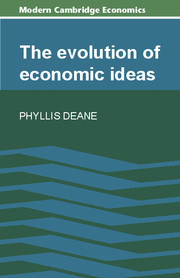Book contents
- Frontmatter
- Series preface
- Contents
- Introduction
- 1 Origins of modern economics
- 2 Adam Smith's theory of value
- 3 Origins of modern growth theory
- 4 Classical monetary theory
- 5 Ricardo on value, distribution and growth
- 6 Scope and methodology of classical political economy
- 7 The marginal revolution and the neo-classical triumph
- 8 The neo-classical theory of value
- 9 The Marxian alternative
- 10 Neo-classical orthodoxy in the inter-war period
- 11 Monetary theory in the neo-classical era
- 12 The Keynesian revolution
- 13 Twentieth-century growth theory
- 14 Methodological divisions in economics since Keynes
- Index of names
- Subject index
11 - Monetary theory in the neo-classical era
Published online by Cambridge University Press: 05 June 2012
- Frontmatter
- Series preface
- Contents
- Introduction
- 1 Origins of modern economics
- 2 Adam Smith's theory of value
- 3 Origins of modern growth theory
- 4 Classical monetary theory
- 5 Ricardo on value, distribution and growth
- 6 Scope and methodology of classical political economy
- 7 The marginal revolution and the neo-classical triumph
- 8 The neo-classical theory of value
- 9 The Marxian alternative
- 10 Neo-classical orthodoxy in the inter-war period
- 11 Monetary theory in the neo-classical era
- 12 The Keynesian revolution
- 13 Twentieth-century growth theory
- 14 Methodological divisions in economics since Keynes
- Index of names
- Subject index
Summary
Although the later classical theorists, such as J. S. Mill, had been aware that theories formulated in real/physical terms could not be applied to the complex system of credit prevailing in the leading commercialised countries, they settled rather readily for the relatively simple monetarist doctrines they had inherited from Ricardo. Nor were their immediate successors among the neo-classical theorists much inclined to explore the links between the supply of money and the level of output to which Thornton had drawn attention at the beginning of the nineteenth century. The main reason for this blind spot was no doubt the fact that economic policy problems originating in the financial sector did not present themselves in such an urgent and acute form as they had in the early years of the nineteenth century or as they were to do in the twentieth century inter-war period. Whatever the reason, the Ricardian example of separating the problems of price determination into two separate compartments of analysis was carried over into the neo-classical paradigm. The structure of relative prices was explained in real, micro, terms – as dependent on marginal cost and/or utility – essentially in terms applicable to a competitive barter economy in long-term equilibrium. The absolute price of each commodity or the general level of prices, was given a monetary, macro, explanation dependent on a short-term fixed relationship between the stock of money and the stock of commodities.
- Type
- Chapter
- Information
- The Evolution of Economic Ideas , pp. 163 - 174Publisher: Cambridge University PressPrint publication year: 1978



